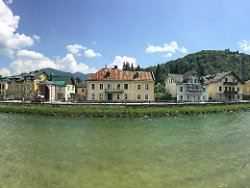Panorama photography makes it possible to take pictures that can give the viewer the feeling of being there themselves. Apps are sufficient for simple snapshots, while special equipment and precision provide more quality.
It's a disappointment: You climbed the 3000er with a lot of effort, but the photos of the fantastic all-round view just look boring. The solution lies in panoramic photography: from simple flat panoramas to 360-degree views to spherical panoramas, there are all kinds of exciting perspectives. The natural enemy of the panoramic photographer are small shifts in perspective: You have to face them with a steady hand and the right equipment.
The principle
"Basically you take several pictures, which you put together afterwards," explains Clemens Conrad, who has been taking panorama pictures professionally for several years. It is important that the individual photos overlap in the edge area, preferably by around 30 percent. "With a fisheye lens with a wide angle of almost 180 degrees, you only need two to four exposures," explains Clemens. The smaller the angle, the more shots are needed to cover the whole area.
Software and apps
Some cameras offer panorama settings, and corresponding apps can be downloaded for smartphones. "The camera is swiveled over the panorama motif like a camcorder," explains Constanze Clauß from the Photo Industry Association. Auxiliary lines or grids indicate which areas still need to be scanned. "Most apps also alert you if you accidentally swivel the camera or smartphone up or down," explains Dieter Bror's "c't" magazine. The app then calculates the final image.
Panorama software
Special software enables stitching, i.e. putting together the images on the PC. While the individual photos are automatically calculated into an overall picture in apps, you can intervene here manually and correct any errors. "360-degree panoramas can also be saved as an interactive panorama that can be viewed on the PC with a special viewer such as QuickTime VR or Java Viewer," says Brors. The viewer can then rotate the subject in all directions and zoom into the picture. VR glasses reinforce this tour effect.
Tools
"For effective pictures you have to be very clean," emphasizes Constanze Clauß. One wobble, one small step, and the perspective is shifted. "Anyone who wants to create high-quality panoramas cannot avoid a camera with a tripod and, if possible, a panorama head, as well as suitable PC software," says Dieter Brors. The tripod is necessary to position the camera without wobbling, the panorama head makes it swiveling. Ambitious photographers also use a so-called nodal point adapter.
Key point
"Usually the pivot point is the camera," explains photographer Conrad. In order to avoid distortions when composing the panorama, the camera must rotate around the so-called nodal point. This is usually not where the tripod is attached, but further forward towards the lens. Nodal point adapters enable the camera to be rotated around this axis.
Anyone who works with a smartphone should try to turn around the mobile phone instead of around their own axis. Because the problem of the apparent change in the position of an object when the observer shifts his own position (parallax) is hardly noticeable with objects that are further away, panoramas of landscapes with the mobile phone are usually not a problem. "The further away the motif, the easier it is," says Conrad, explaining this basic rule. If you want to show the ground on your panorama, you should choose a monochrome background without complicated structures. This makes it easier to retouch the stand position later.
exposure
"In one and the same panorama, the photographer has to deal with different light situations while taking the picture", explains Constanze Clauss another problem. "In direct sunlight, the sun probably only appears as a white ball and dark areas almost black," adds photographer Conrad. This problem is most serious in dark rooms with brightly lit windows. Bracketing helps here.
. (tagsToTranslate) technology (t) digital cameras
